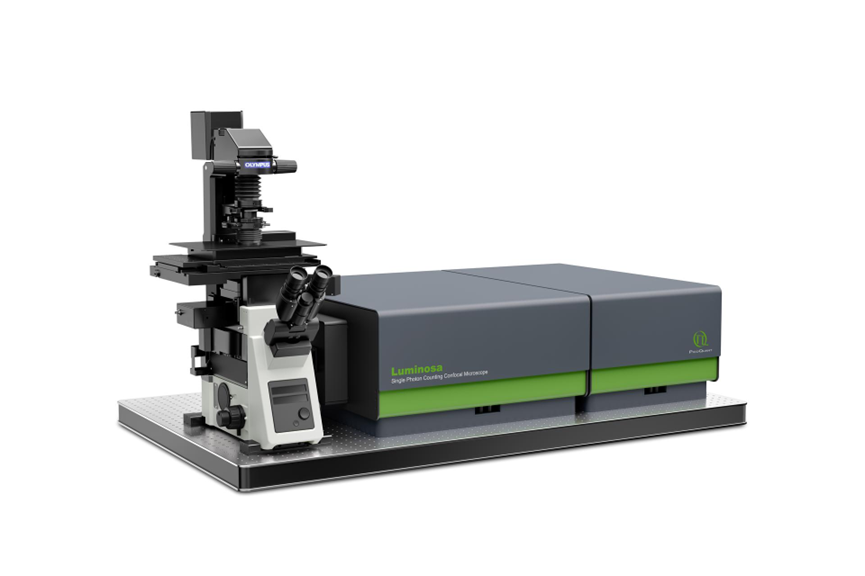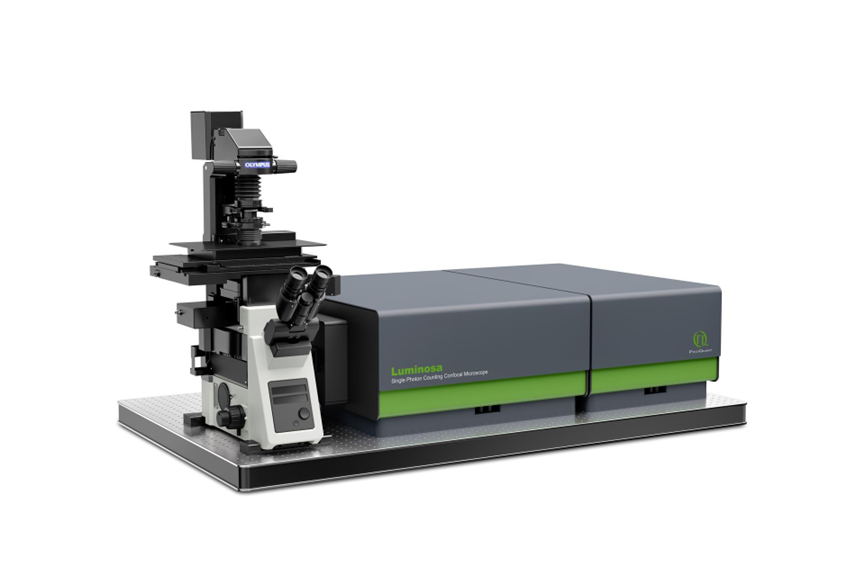
看見癌細胞如何「挾持」自噬機制逃避死亡:
Luminosa 共軛焦顯微鏡揭示重金屬致癌機制
前列腺癌是全球男性第二常見的癌症,平均每八位男性就有一位將面臨這項診斷。除了遺傳因素外,環境中的重金屬(如鎘 Cd)暴露,也逐漸被認為是關鍵的致癌因子之一。但這些有毒元素到底是如何在細胞層級引發癌症的?
近期由德州農工大學與路易斯維爾大學研究團隊發表於 Science Advances 的研究揭示:當前列腺細胞長期暴露在鎘中,會啟動一條「逃避細胞死亡」的分子通路,成功轉變為惡性癌細胞。研究也透過 PicoQuant 的 Luminosa 共軛焦螢光顯微鏡,深入觀察自噬(autophagy)機制如何被癌細胞劫持,這是以往難以捕捉的細胞策略。
研究亮點:癌細胞的隱形生存通道
科學家發現,長期接觸鎘後,原本正常的前列腺上皮細胞會轉化為惡性細胞(CTPE 細胞),背後的主因是「巨自噬」過程遭到干擾。具體來說,研究揭示了一條促進癌細胞存活的關鍵軸線:
NF-κB → PLAC8 → BCL-xL
研究團隊觀察到:
- PLAC8 的過度表現 會與 LC3B 結合、排擠 LAMP1,進而阻礙自噬體與溶酶體的融合。
- NF-κB (p65) 可穩定 PLAC8,並促使其累積於細胞質中。
- BCL-xL 為抗細胞凋亡的重要基因,是 PLAC8 下游的表現產物,使細胞更能對抗死亡訊號。
- 值得注意的是: 針對這條軸線任一環節進行抑制,皆可恢復自噬作用並抑制腫瘤生長 。
Luminosa 共軛焦顯微鏡的關鍵角色

這項機轉的揭露,仰賴的是高解析、可定量的影像技術,而 PicoQuant 的 Luminosa 共軛焦顯微鏡 正是研究團隊不可或缺的核心工具。
Luminosa 專為高階螢光應用設計,這次研究中,透過多色免疫螢光搭配單光子計數影像技術,研究者能夠:
- 準確比對 LC3B-LAMP1 與 LC3B-PLAC8 的共定位情況
- 利用 ImageJ/JACoP 套件計算 Pearson 相關係數 ,進行量化分析
- 直接證實 PLAC8 取代 LAMP1 ,導致自噬流停滯 的現象
這些定量級別的影像成果,正是 Luminosa 所搭載的高靈敏單光子計數技術所帶來的優勢,傳統系統難以達成如此細膩的觀察與分析。
為什麼這項研究重要?
這項研究不只揭示了重金屬致癌的分子機制,更為相關癌症的治療與早期診斷提供了全新方向。從靶點開發、藥物設計到病理機轉釐清, 高解析影像 與 精準定量分析 將是不可或缺的基礎。
Luminosa 不僅助力科研人員深入細胞內部,更縮短了從「基礎研究」走向「臨床應用」的距離。
點此閱讀完整研究論文
深入了解 Luminosa 共軛焦顯微鏡
Visuality How Cancer Cells Hijack Autophagy to Survive
Prostate cancer is the second most common cancer in men worldwide, with 1 in 8 men facing this diagnosis during their lifetime. While genetic factors play a role, environmental influences—such as exposure to heavy metals like cadmium (Cd)—are increasingly recognized as critical contributors. But how do these toxic elements drive cancer development at the cellular level?
A recent Science Advances study from researchers at Texas A&M and the University of Louisville uncovered a molecular escape route that allows cadmium-exposed prostate cells to evade cell death. This discovery not only advances our understanding of autophagy disruption but also demonstrates the power of confocal microscopy using our confocal microscope Luminosa in revealing these hidden cellular strategies.
The Breakthrough: A Hidden Survival Pathway
Prolonged cadmium exposure transformed normal prostate epithelial cells into malignant ones (CTPE cells). The culprit? A disruption in macroautophagy, the process cells use to remove damaged components.
Researchers identified a survival-promoting axis: NF-κB → PLAC8 → BCL-xL
Here’s what they found:
- PLAC8 upregulation disrupts autophagy by binding to LC3B and displacing LAMP1, blocking autolysosome formation.
- NF-κB (p65) stabilizes PLAC8, promoting its cytoplasmic localization.
- BCL-xL, a well-known survival gene, is upregulated downstream of PLAC8, helping cells resist apoptosis.
Therapeutic potential: Inhibiting any component of this axis restored autophagy and reduced tumor growth in vivo.
Where Luminosa Made the Difference

Unraveling this mechanism required high-resolution, quantitative imaging—and that’s where PicoQuant’s Luminosa confocal microscope played a pivotal role.
Luminosa, designed for advanced fluorescence applications, enabled researchers to visualize the cadmium-driven disruption of autophagy with unmatched precision. Using multicolor immunofluorescence and photon-counting confocal imaging, they could:
- Quantify LC3B-LAMP1 vs. LC3B-PLAC8 colocalization,
- Compute Pearson correlation coefficients using ImageJ/JACoP,
Reveal that PLAC8 actively displaces LAMP1, halting autolysosome formation.
This level of image-based quantification would not have been possible without Luminosa’s advanced single-photon counting technology.
Why It Matters
This study does more than uncover a molecular mechanism—it opens doors to new therapeutic targets for heavy metal–induced cancers. From early detection to drug development, the implications are profound. With Luminosa enabling precise, reproducible, and high-content imaging, researchers are closing the gap between molecular insight and clinical impact.


